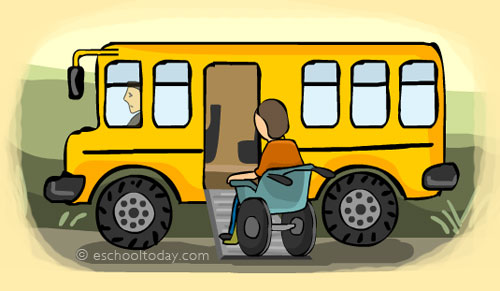 |
What is accessibility?
Accessibility in relation to disability is the model where things in society are planned and done with everyone, young, old, with or without disability in mind. Particularly with public places and utilities, it is now a requirement that the design of buildings, automobiles, roads and walkways etc are built to be accessible by all.
Here are a few examples:

 Public transport must be accessible to people who use wheelchairs. Public transport must be accessible to people who use wheelchairs.
 Parking spaces are closest to entrances to make it easier for people with disability to get in. Parking spaces are closest to entrances to make it easier for people with disability to get in.
 Raised lettering and braille are used (such as those on signs and elevators) for people with sight loss to use in finding their way Raised lettering and braille are used (such as those on signs and elevators) for people with sight loss to use in finding their way
 Hallways are free from things that can be barriers, so that people with sight loss and wheelchairs can move about more freely, especially in an emergency. Hallways are free from things that can be barriers, so that people with sight loss and wheelchairs can move about more freely, especially in an emergency.
 Ramps are available in building with stairs so that people with wheelchairs are not kept out. Ramps are available in building with stairs so that people with wheelchairs are not kept out.
It is very important that all public spaces and buildings respect the need to use accessible design.
One good way to achieve this level of accessibility in society is to engage and employ people with disability. This way, they can guide the process with their own experience. Designers can also have a simulated disability experience so that they can have a better appreciation of the needs of people with disability.
Universal design
Universal design helps make life simple for everyone. To achieve this there are seven things to note:
 Equitable: For instance — A ramp to a door instead of stairs to the door. Equitable: For instance — A ramp to a door instead of stairs to the door.
 Flexible: For instance — The use of flashing lights with sirens or beeping sounds in warning or emergency situations. This way people with hearing and sight loss can know what to do. Flexible: For instance — The use of flashing lights with sirens or beeping sounds in warning or emergency situations. This way people with hearing and sight loss can know what to do.
 Simple and intuitive: For instance — the boy/girl signs on bathroom doors are easier for people to relate to and understand. Simple and intuitive: For instance — the boy/girl signs on bathroom doors are easier for people to relate to and understand.
 Informative: For instance — a pictorial sequence of how to wash your hands is more useful for children that textual description. Informative: For instance — a pictorial sequence of how to wash your hands is more useful for children that textual description.
 Tolerance for error: For instance — toys for little children must be big and sturdy enough so that they cannot swallow or break them. Tolerance for error: For instance — toys for little children must be big and sturdy enough so that they cannot swallow or break them.
 Low physical effort: For instance — a lever door handle is always better than the round door knobs, because people without hands can manage to turn the lever. Low physical effort: For instance — a lever door handle is always better than the round door knobs, because people without hands can manage to turn the lever.
 Size and space: For instance — toilet units in the bathroom for people with disability should be low and have a lot of space in there. Size and space: For instance — toilet units in the bathroom for people with disability should be low and have a lot of space in there.
 
|
 |
